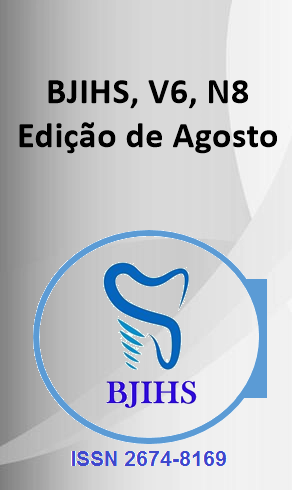Resumo
Considering the increasing use of intravenous ketamine in pediatric emergency care, particularly for sedation, analgesia, and management of severe conditions such as traumatic brain injury and suicidal ideation, there is a need to critically evaluate its efficacy and safety in these settings. This study aims to systematically review and analyze various studies that have investigated the use of intravenous ketamine bolus in pediatric emergency care, focusing on its clinical outcomes, safety profile, and overall effectiveness. To achieve this, a narrative literature review was conducted, examining studies published between 2014 and 2023. The review included randomized controlled trials, observational studies, and case reports sourced from reputable databases such as PubMed, Scopus, and Web of Science. The results of the review indicate that intravenous ketamine is effective in providing rapid sedation and analgesia, with a favorable safety profile when administered by trained healthcare professionals. Specifically, it was observed that ketamine significantly reduces pain intensity, lowers suicidal ideation, and effectively manages intracranial pressure in children with severe traumatic brain injury. However, the review also highlights the variability in recovery times and the incidence of mild to moderate side effects, such as dizziness, nausea, and drowsiness. In addition, the need for rescue doses was more frequent in intravenous administration compared to intramuscular routes, though intravenous administration offered quicker onset and shorter duration of action. It is concluded that while intravenous ketamine is a valuable tool in pediatric emergency care, its administration should be carefully monitored, particularly in high-risk patients, to mitigate potential adverse effects. Further research is needed to refine dosing strategies, explore long-term outcomes, and establish standardized protocols to maximize the therapeutic benefits of ketamine while minimizing risks.
Referências
AHERN, Terence L. et al. Low-dose ketamine infusion for emergency department patients with severe pain. Pain Medicine, v. 16, n. 7, p. 1402-1409, 2015.
BARTOLI, Francesco et al. Ketamine as a rapid-acting agent for suicidal ideation: a meta-analysis. Neuroscience & Biobehavioral Reviews, v. 77, p. 232-236, 2017.
GHARAVIFARD, Mohammad; ZADEH, Behnaz Boroumand Reza; MOGHADAM, Hamid Zamani. A randomized clinical trial of intravenous and intramuscular ketamine for pediatric procedural sedation and analgesia. Emergency, v. 3, n. 2, p. 59, 2015.
GUTHRIE, Anne Marie et al. Use of intranasal ketamine in pediatric patients in the emergency department. Pediatric emergency care, v. 37, n. 12, p. e1001-e1007, 2021.
HAUSFELD, Katelyn et al. Randomized prospective clinical trial comparing room temperature and warmed intravenous fluid boluses on pediatric patients' comfort. Journal of Pediatric Nursing, v. 30, n. 6, p. e3-e9, 2015.
JAIN, Anuj et al. Intramuscular ketamine provides better sedation and scan conditions in children undergoing magnetic resonance imaging: A single-blinded observational study. Journal of Neurosciences in Rural Practice, v. 14, n. 3, p. 477, 2023.
KASHANI, Parvin et al. The effect of intravenous ketamine in suicidal ideation of emergency department patients. Emergency, v. 2, n. 1, p. 36, 2014.
LAWS, Jennifer C. et al. Acute effects of ketamine on intracranial pressure in children with severe traumatic brain injury. Critical care medicine, v. 51, n. 5, p. 563-572, 2023.
MADATHIL, Shamnad et al. ‘NOPAIN-ROP’trial: Intravenous fentanyl and intravenous ketamine for pain relief during laser photocoagulation for retinopathy of prematurity (ROP) in preterm infants: A randomised trial. BMJ open, v. 11, n. 9, p. e046235, 2021.
OLABARRI, Mikel et al. Safety of ketamine for reducing fractures in a pediatric emergency department. Emergencias, v. 34, p. 339-344, 2022.
PRUITT, Louis Gordon et al. Intravenous fluid bolus rates and pediatric diabetic ketoacidosis resolution. The American journal of emergency medicine, v. 37, n. 12, p. 2239-2241, 2019.
ROSS, Catherine E. et al. Physiologic response to pre-arrest bolus dilute epinephrine in the pediatric intensive care unit. Resuscitation, v. 126, p. 137-142, 2018.
SANKAR, Jhuma et al. Fluid bolus over 15–20 versus 5–10 minutes each in the first hour of resuscitation in children with septic shock: a randomized controlled trial. Pediatric Critical Care Medicine, v. 18, n. 10, p. e435-e445, 2017.

Este trabalho está licenciado sob uma licença Creative Commons Attribution 4.0 International License.
Copyright (c) 2024 Eduarda Araújo, Tadeu Romagnoli Neto, Ana Beatriz Fernandes Camacho, Saori Wakimoto, Thaisa Mayumi Matsui, Eloá Vicentin Cesnik, Bergson Lacerda Formiga Barros, Catarina Nogueira Carvão Aguiar Valle Barbosa, Cecília Lorraine Santos Fernandes, Clara Tamiozzo Arraes, José Alberto Pereira Coelho Filho, Davis Jucá Magalhães Filho, Gabriela Dal Bo Cece de Castro, Hildo Santiago Reis de Aguiar, Hyasmin Cristina Ferreira Fonseca, Izabela Ferrari Tonelli de Souza, Kuezia da Veiga Gonzales Serra, Letícia Portela Fales, Luana Tamiozzo Arraes, Rafaelly Maria Pinheiro Siqueira, André Luiz Cunha Cavalcante, Ricardo Bruno Araujo Nunes, Sofia Brito Lourenço, Thainara Ferreira Campos, Yuri Gabriel de Amorim Dutra, Brenna Cardoso Magalhães Lyra
